Adrian Scott Stokes – Traveller Towards Light
Posted on: 22 April 2021 by by Amanda Draper, Curator of Art and Exhibitions in 2021
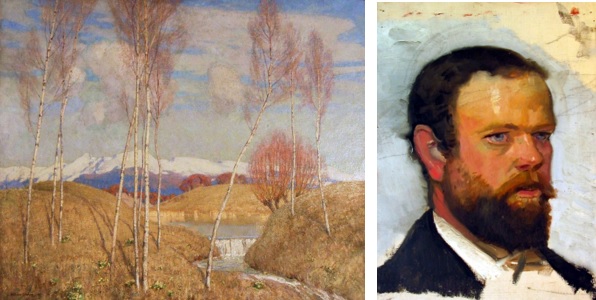
The sharp sunlight of spring brings a fresh clarity to nature and one painting in our collection demonstrates this beautifully: ‘Early Spring in the Austrian Tyrol’ by Adrian Scott Stokes. Let’s discover more about this much-travelled landscape artist from Merseyside.
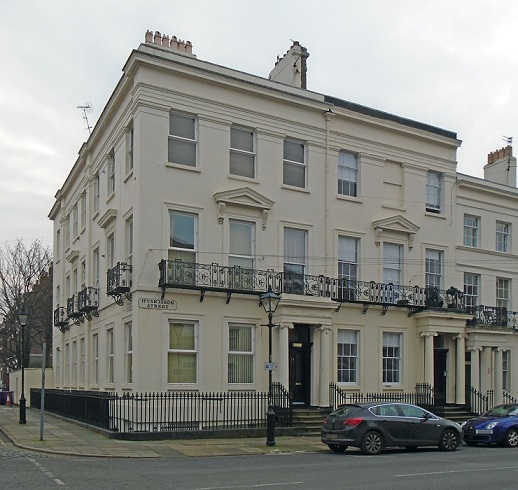
28 Huskisson Street, Liverpool. Photo by rodhullandemu via Wikimedia creative commons licence
Made on Merseyside
Stokes rose to the top of the British art establishment but it all started on Merseyside when he was born at 77 Hoghton Street, Southport in December 1854. By 1860 the family were living at 28 Huskisson Street in Liverpool and then later in the Rainhill area. Stokes’ father was an inspector of schools for Lancashire and keen that his sons had professional careers with good prospects. Stokes was sent to work for a Liverpool cotton broker but it was not the career for him. His parents moved to London in 1871 following a major promotion for his father and he went with them.
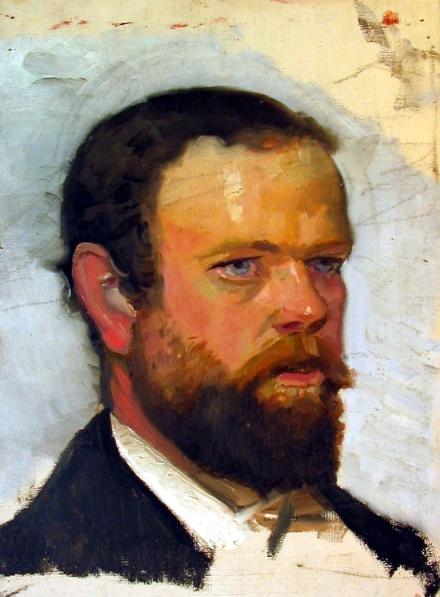
Unfinished portrait of Adrian Scott Stokes, 1888 by Michael Ancher (oil on canvas). Creative Commons licence.
Royal Academy beckons
Stokes’ move to London coincided with a change of career. He had already studied art at the Liverpool Institute, probably at night-class, and successfully submitted some watercolours to the Royal Society of British Artists winter exhibition of 1871. Buoyed by this, he applied and was accepted to study art full-time at the Royal Academy School the following summer and quickly progressed. Eighteen months later Stokes exhibited a small painting at the Dudley Gallery in Piccadilly and then, in 1874, had three large paintings accepted for the prestigious Royal Academy summer exhibition, one of which sold at the private view. His early works tended to have historical or literary subjects but the lure of landscape painting began to emerge, allied with a passion for travel.
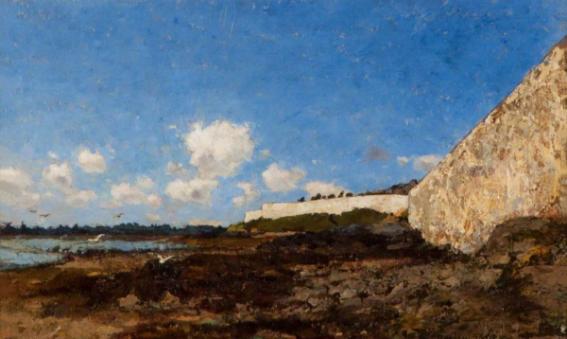
By the Walls of the Hougue, 1881 (oil on canvas). Collection of Canterbury Museums & Galleries
France
In 1876 Stokes set off for the French artists’ colony at Barbizon in the central-north of France. It had been an important centre for innovative landscape painting since the 1830s with an emphasis on the realistic depiction of people and environment painted in situ. Visiting artists’ colonies where Stokes could meet and share ideas with fellow painters, and where he could experience different effects of light, was a recurring pattern through his career.
Stokes travelled back and forth to France over the next few years, remaining true to the Barbizon ideals and painting out-doors wherever possible. In the painting ‘By the Walls of the Hougue’ he uses the strong sunlight to bring out texture in the grey stone walls and rocky brown foreground but seems to be wrestling to find a focus for the composition. Nevertheless, the painting was one of five by Stokes to be displayed at the Royal Academy exhibition of 1882. But it was at Pont-Aven, an artists’ colony in Brittany, where Stokes came across the biggest influence on his life.
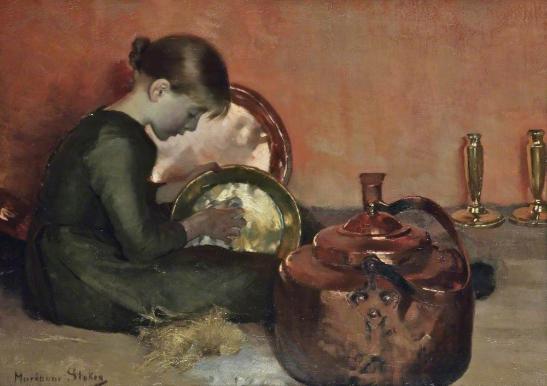
Polishing Pans by Marianne Stokes, c.1887 (oil on canvas). Collection of Walker Art Gallery, National Museums Liverpool
Marianne Stokes
Stokes met his wife, Marianne, at Pont-Aven in 1883. This highly accomplished artist was born in Graz, Austria, and worked under her maiden name of Marianne Preindlsberger until her marriage to Stokes in 1884. Rather than landscapes, Marianne concentrated on figure studies. Her earlier works followed realist principles, showing people (often children) working or at leisure in rural locations. Her painting ‘Polishing Pans’ demonstrates her technical ability to capture the lustre of metalware but also the touching absorption of the young girl concentrating on the task in hand. As her career progressed, Marianne turned to highly stylised medieval and religious subjects painted with exquisite attention to detail. She exhibited internationally and was one of the most successful women artists of her day.
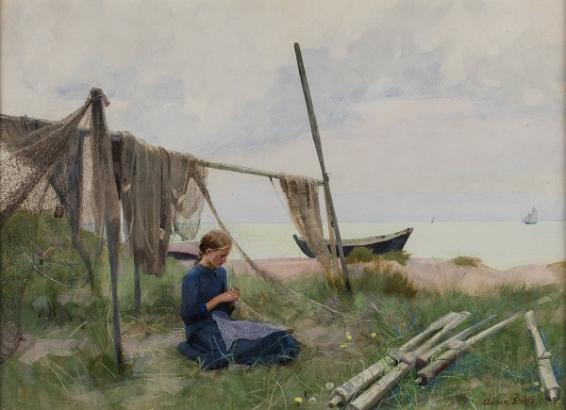
By the Cattegat, c.1886 (Watercolour, bodycolour & pencil). Collection of Gallery Oldham
Denmark
Among many things the couple had in common was a love of travel. Having honeymooned on Capri, they set off a year later to the Danish artists’ colony at Skagen, the most northern point of the country and its main fishing port. It is a finger-like peninsular jutting out into the sea and its white sand gives a unique light to the town which had been attracting artists since the 1830s. The artistic influence of Marianne on Stokes in the early years of their marriage can be seen in ‘By the Cattegat’ where Stokes’ composition centres around a young girl mending a fishing net, while the land and sea melt away into a milky light in the background. The Stokeses visited Skagen for the two consecutive summers of 1885/6.
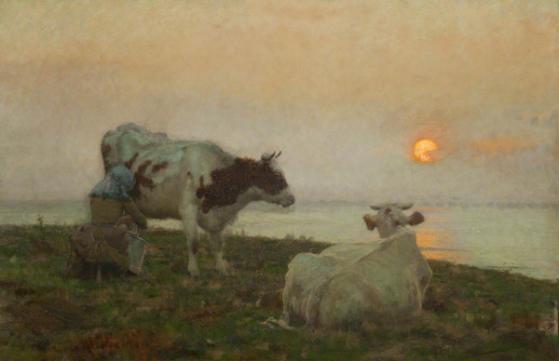
The Setting Sun, c.1891 (oil on canvas). Collection of the Harris Museum & Art Gallery, Preston
Cornwall
In June 1887 the couple settled in St Ives where, again, there was an established artists’ colony. It was similar to Skagen in many ways: a fishing port set on a peninsular with a sunny microclimate that give it a clarity of light not found in other parts of the country. Stokes’ interest in light effects is shown in ‘The Setting Sun’ where, despite the massive bulk of the two cows and the busy ministrations of the milkmaid, the composition is dominated by the orange orb of sinking sun which casts its glow over the sea and sky. Stokes was instrumental in establishing the St Ives Art Club and was appointed its first President in 1890. The Stokeses would spend much of their time in Cornwall until around 1900, but it did not stop them from continuing their travels abroad.
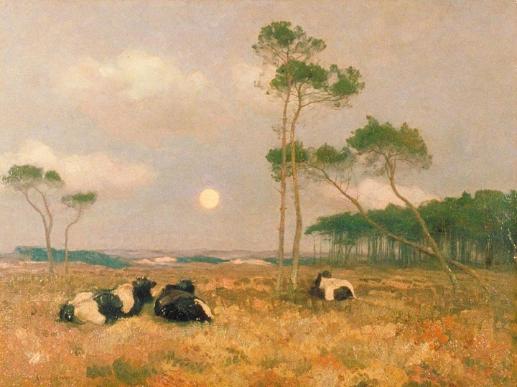
Moonrise on the Zuyderzee, c.1899 (oil on canvas). The Government Art Collection
Holland
In 1899 the couple visited the Netherlands and Stokes recorded that it was the first place that suited he and Marianne equally as artists. They travelled around but stayed longest in Volendam where, yet again, the couple found themselves amongst other artists who had converged on the picturesque spot. This attractive fishing village about 20km from Amsterdam had a population that was mainly Catholic. As a Catholic herself, Marianne was inspired by the traditional ways and costume of the locals, especially the women’s white caps. Stokes was entranced by the low-lying landscape and its tranquillity. His painting ‘Moonrise on the Zuyderzee’ continues his interest in changing light conditions. Its grey tonality follows that of the Hague School, a group of artists working around that area since the 1860s, whose landscapes are typified by their muted colours. In this painting, we see the bended forms of spindly trees which add drama and became a feature of Stokes’ later work.
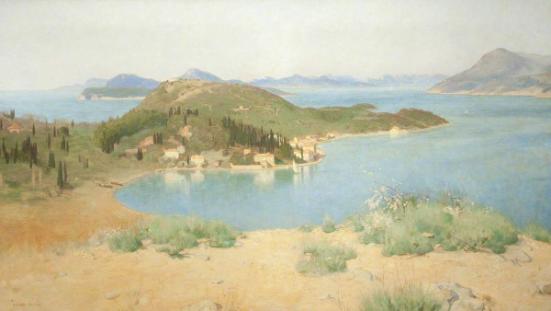
Islands of the Adriatic, 1906 (oil on canvas). Collection of the Harris Museum & Art Gallery, Preston
The Adriatic, Hungary and Romania
The Stokeses visited Hungary five times, beginning in August 1905, journeying via the Adriatic coast. A stunning legacy of their travels is ‘Islands of the Adriatic’; a sun-baked vista looking northwards from Gravosa (also known as Grŭz) just outside Dubrovnik in what is now Croatia. Stokes revels in the still, aquamarine waters reflecting the light-coloured houses of the bay. The painting was later illustrated in his book ‘Landscape Painting’ (1925). Inland, the Stokeses travelled through central Hungary to Transylvania and the Carpathian Mountains painting all the while. The result was several exhibitions and a book, ‘Hungary’, with text by Stokes and colour illustrations by the couple published in 1909 (see link to the book below).
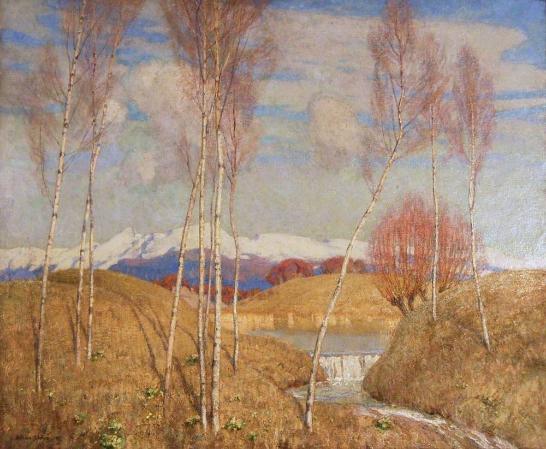
Early Spring in the Austrian Tyrol, 1916 (oil on canvas). Collection of the VG&M, University of Liverpool
The Alps
The Stokeses relocated to Munich in 1909 and from there journeyed around the Alps and Dolomites, often in the company of the great American artist John Singer Sargent who had been a friend since 1885. Although famed for his bravura portraits, he actually preferred painting landscapes in watercolour and, like the Stokeses, travelled extensively in search of inspiration. But war encroached and, by 1915, the couple were unable to return to their Munich base and were restricted to Austria for a while before spending much of the war in Switzerland. Stokes’ work of this period, such as ‘Early Spring in the Austrian Tyrol’, rejoices in the clarity of light found in the Alpine landscape. And yet the stream acts as a barrier to further progress towards the mountains, while the silver birches seem to stand guard. It is, perhaps, a reflection of Stokes’ feelings of restricted movement at that time despite the glory of his surroundings.
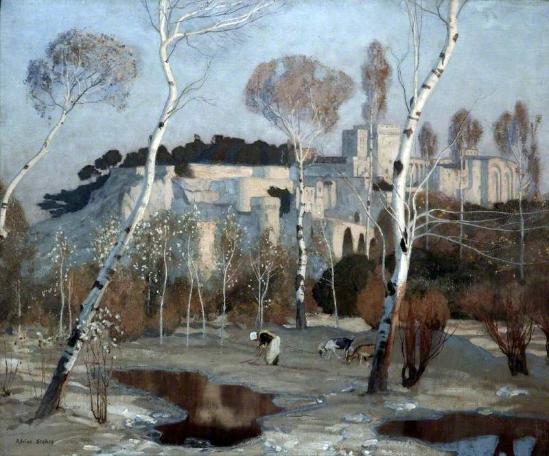
The Palace of the Popes, Avignon, 1922 (oil on canvas). Collection of The Atkinson, Southport
Later life and continued travels
Stokes had been elected a full Royal Academician in 1919 and, in 1921, he and Marianne settled more permanently in London. It did not stop their restlessness and Stokes’ paintings from the 1920s record travels to Scotland, Italy and Southern France. One of his most celebrated paintings of this later period is ‘The Palace of the Popes, Avignon’. A striking symphony of silver and russet tones, it has a fairytale quality far removed from Stokes’ earlier more realist works. Fittingly, it was purchased for the collection of The Atkinson Art Gallery in Southport, so Stokes’ life had come full circle.
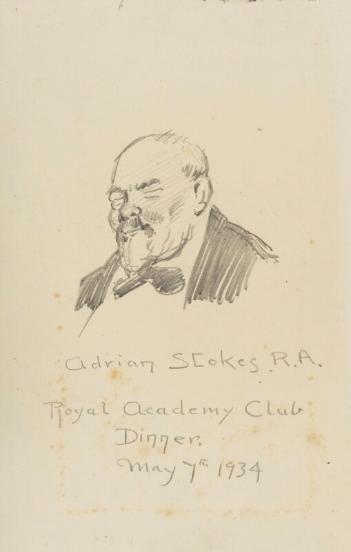
Sketch portrait of Adrian Stokes by Fred Roe, 1934 (pencil). National Portrait Gallery, London NPG D43215
A last controversy
Sadly, Marianne died in 1927 at the age of 72. Stokes continued to paint, exhibit and socialise. He was popular with his fellow artists and several drew fond sketches and caricatures of him. He was used to being featured in the arts pages of newspapers but, on 4 May 1934, Stokes made headline news when he heckled the Prime Minister, Ramsey Macdonald, who was giving a speech at a Royal Academy banquet. Stokes felt the PM was talking too much about politics and not at all about art. Other guests, including the Prince of Wales, thought it hilarious but Stokes was rebuked by the President of the Royal Academy, who also sent a written apology to Macdonald. Stokes was unrepentant.
Adrian Scott Stokes died the following year aged 80.
Further Information:
Utmost Fidelity: The Painting Lives of Marianne and Adrian Stokes by Magdalen Evans (Sansom & Company, 2009)
Hungary painted by Adrian and Marianne Stokes (1909)
Adrian Scott Stokes and Marianne Stokes are both profiled in the Oxford Dictionary of National Biography https://www.oxforddnb.com/
Paintings of Adrian Scott Stokes on Art UK:
https://artuk.org/discover/artworks/search/actor:stokes-adrian-scott-18541935#undefined
https://artuk.org/discover/artworks/search/actor:stokes-adrian-scott-18541935#undefined
Paintings of Marianne Stokes on Art UK:
https://artuk.org/discover/artists/stokes-marianne-18551927
https://artuk.org/discover/artists/stokes-marianne-18551927
Keywords: Adrian Scott Stokes, Marianne Stokes, Merseyside, Royal Academy, Landscape Painting.